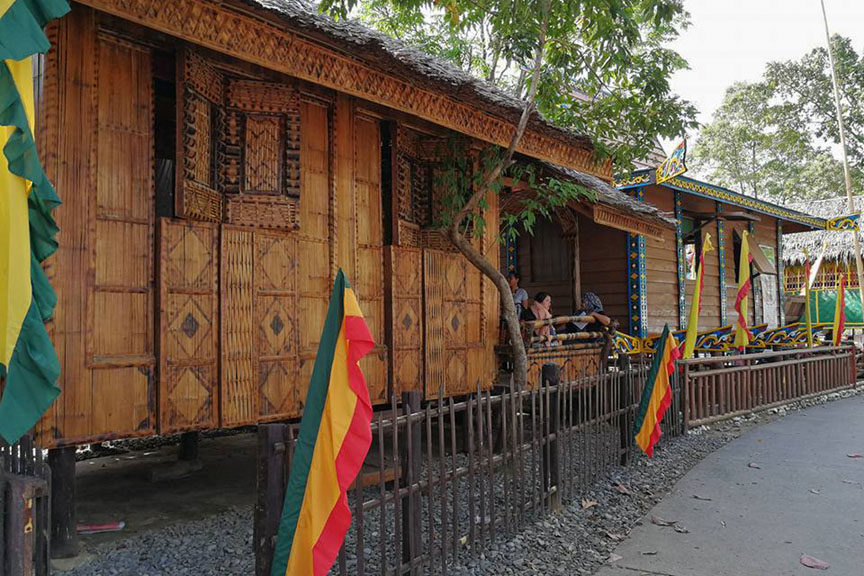DAVAO CITY (MindaNews / 15 Feb) – The Kadayawan Cultural Village at the Magsaysay Park here that opened during the Kadayawan Festival August last year to showcase Davao City’s 11 recognized tribes has helped change the way people look at the Moro and the Lumad people and has since become a go-to destination for cultural tours.
 The Kadayawan Cultural Village at the Magsaysay Park in Davao City. MindaNews photo by ANTONIO L. COLINA IV
The Kadayawan Cultural Village at the Magsaysay Park in Davao City. MindaNews photo by ANTONIO L. COLINA IV
Fhebelyn Mohamad, in-charge of the tribal house of Kagan, told MindaNews Thursday that they are all praises to the city government for providing them a place where they can showcase a unity sustained by the different tribes in the city despite cultural differences and beliefs.
The harmonious relationship of the 11 tribes, comprising six Moro tribes (Tausug, Maguindanaon, Iranun, Kagan, Maranao, and Sama) and five Lumad tribes (Klata, Ata, Ubo Manuvo, Matigsalog, and Tagabawa) has left many of the tourists in awe because of its distinction from the rest of the tribes elsewhere in Mindanao, she said.
Mohamad added they have seen changes in the attitude of the locals towards indigenous tribes in that they have become more appreciative of their identities by taking a glimpse of their daily lives – traditions and cultural practices – right inside an indigenous household.
She said they are thankful because the cultural village helped raise the awareness about Kagan, a tribe that she said is not as widely known compared with other Moro tribes in the city.
She said they no longer get discriminated as often as they had been in the past because of the better cultural understanding. Some visitors, Mohamad added, would even request for selfies while others would ask to try on their traditional costumes.
“It makes us happy despite the stress because they appreciate our traditional costumes. We allow them to put it on for as long as they will not disrespect our traditional costumes,” she said.
Tour package
City Tourism Office head Generose Tecson said in an interview that the cultural village has been frequented by an influx of visitors – around 8,000 to 9,000 a month – since the Kadayawan celebration last year.
Tecson said they are working on regular cultural performances on weekends and are assisting the Lumads and Moros to enhance their handicrafts and delicacies to sell at their respective tribal house, which helps in their livelihood.
“It depends on the tribes. We talk to them, we capacitate them – they make the rules and we are just there to listen to them. We also give them advice how they can improve on their products,” she said.
Tecson said the visit to the cultural village has been integrated into the tour packages offered by local tour operators in the city.
Motivation
Mohamad said they sell native delicacies and various crafts, ranging from bags and wallets made of “malong” created by the women in their tribe.
 Products of the Kagan tribe being sold at the Kadayawan Cultural Village. MindaNews photo by ANTONIO L. COLINA IV
Products of the Kagan tribe being sold at the Kadayawan Cultural Village. MindaNews photo by ANTONIO L. COLINA IV
On busy days, she said their products sell like hotcakes, which motivates them to produce more and better products.
“It’s a big help because, at least now, we feel that we are no longer used by other sectors who take advantage of the indigenous peoples. We can make our voice heard here,” Mohamad added.
Rovelyn Ali Bontilao, in-charge of the Ata tribal house who hails from Paquibato District, said they are wishing for a better life for the Lumad and Moro people in the city.
She said they hope the government would make their cultural village permanent because it is better than a museum where all that the visitors can see are pictures and a few artifacts unlike in the village where they can immerse in the culture and interact with the tribes.
Bontilao said the village promotes continuity of the cultural practices of IPs, most especially for the younger generation of Lumad people, and encourages them to showcase their true identities as the early settlers here. (Antonio L. Colina IV / MindaNews)
